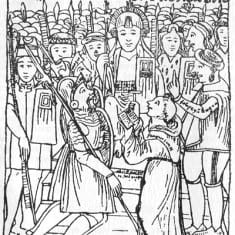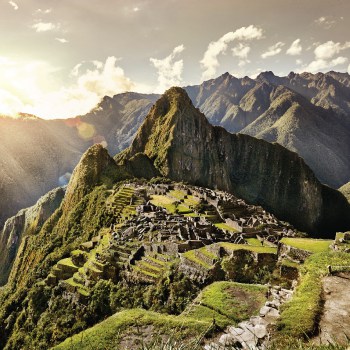Inca Population Estimates
The geographical range of the Inca Empire has been quite reliably mapped using existing archaeological evidence, but the population of the empire — the Tawantinsuyu — remains something of a mystery. No decipherable Inca records remain, while modern-day studies have resulted in a range of estimated totals.
Inca Population and Quipu Records

Pizarro meets the Inca Atahualpa
The Incas kept detailed records of their population, from birth to deaths to the exact nature of individuals in terms of the potential tasks and roles for which they were suited. In this way, the Incas could maintain a high level of control and administrative order over the expanding realm.
These records, however, were kept on Inca quipus, knotted-cord devices that were all but destroyed during the Spanish Conquest. The surviving quipus, meanwhile, guard their secrets closely. Modern studies have yet to decipher the quipu code; it’s quite possible that only the original creator of the quipu (an Inca accountant known as a quipucamayoc) could interpret its meaning.
Modern Inca Population Studies
A number of studies from the 1930s onwards have resulted in a range of estimated totals for the pre-conquest Inca population (the total population contained within the Tawantinsuyu, both the ruling Incas and those they controlled). The following historians have used various methodologies in an attempt to calculate the population:
- Philip Ainsworth Means (1931): Using the decimal-based administrative system adopted by the Incas, Means surmised that each province in the Inca Empire contained between 200,000 and 400,000 people. Each of the four quarters of the empire contained about 20 provinces; adding these populations together, Means calculated the overall Inca population to be between 16 and 32 million.
- John Rowe (1946): Rowe used figures taken from the Spanish census of 1571 (Viceroy Toledo) to calculate an approximate pre-conquest Inca population. According to Rowe, “it is not unreasonable to apply the ratio of totals (4:1) to the population reported in 1571, and estimate the total population of the Andean area in 1525 at about 6 million.”
- Henry Dobyns (1966): Dobyns also used a depopulation ratio (which he calculated as 25:1), but this time using data from the entire Western hemisphere. Rowe’s final population figure came to 37.5 million for the pre-conquest Andean region.
- C.T. Smith (1970): Smith also compared Spanish census data with pre-conquest estimates, arriving at a population count of a little over 12 million people for the Andean region.
- Nathan Wachtel (1977): In The Vision of the Vanquished, Wachtel followed a similar method to that used by Smith. Watchel’s population total came in at approximately 10 million.
- Noble David Cook (1981): In Demographic Collapse: Indian Perú, 1520-1620, Cook used three different methods to calculate the pre-conquest Inca population, acknowledging the fact that all were limited. His ecological model (maximum population based on how much food the Incas could produce) gave a maximum supportable population of 13.3 million. A second model, based upon mortality rates caused by Columbian Exchange diseases, gave a pre-conquest population of between 3.25 and 8 million. Using the 1571 Spanish census data to calculate a figure for 1520, Cook arrived at an Inca population of between 4 and 14 million (Cook saw this method as the most reliable).

The Pre-Conquest Inca Population: General Consensus
According to historian Gordon Francis McEwan (The Incas: New Perspectives, 2006), the complexities of the Inca population problem and the limitations of the various methods of calculation make the determination of an accurate figure unlikely. However, the range of results gathered has helped to give a vague yet valuable estimation.
McEwan states that “Most modern Inca scholars seem to accept and work with figures ranging between 6 million and 14 million people.” This estimated pre-conquest population, even at the lower end, is a stark figure when compared with the 1571 post-conquest census, which reveals a greatly reduced Inca population of less than 1.5 million people.
References:
- Gordon Francis McEwan – The Incas: New Perspectives
- John Rowe – Inca Culture at the Time of the Spanish Conquest
- Nathan Wachtel – The Vision of the Vanquished











2 comments for “Inca Population Estimates”